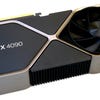Nvidia GeForce RTX 4090 review: a new level in graphics power
Blitzes the games of today, built for the titles of tomorrow.
The next generation of graphics performance is finally in our hands - and it's one of the biggest generational leaps we've ever seen. Back in the day, comparing RTX 3080 to RTX 2080 showed up some impressive gains - but the performance multipliers are at a new level when considering how the new RTX 4090 stacks up against prior GPU champions RTX 3090 and RTX 3090 Ti. In fact, on a broader level, the delivery of so much performance actually poses problems in creating a balanced gaming PC: as you'll see in our analysis, many of the games we're benching are now hitting CPU limitations. Even at 4K resolution. Even at maximum settings. The heaviest of ray tracing workloads though? RTX 4090 is simply phenomenal.
In fact, the power of the new card actually poses some fundamental questions: if CPUs can't fully feed it, will it be a good match for your surrounding hardware? More importantly, what are the current real world applications for the card? Ultimately, if you have a 4K 120Hz+ display (I use a 48-inch LG CX OLED), you're in good shape for matching your display with the capabilities of the hardware. If you're gaming at 1440p or lower, or even if you have a 4K 60Hz screen, there's a good chance that the RTX 4090 simply offers too much performance... on the games of today, at least.
This leads us on to a key message Nvidia delivered at the RTX 4000 launch - one overshadowed by the controversy surrounding the RTX 4080's specs and pricing. The truth is, we've yet to emerge from the cross-gen malaise and our one hint at the future of gaming comes from Unreal Engine 5 and The Matrix Awakens. UE5 seems to be the engine of choice for the games of tomorrow, where we should see the new wave of GPUs more taxed. Nvidia is thinking beyond that though, using the extra performance of RTX 4000 in combination with a new DLSS 3 to make new gaming experiences a reality. We saw RTX Remix, modernising older titles with full path-tracing. We also saw Cyberpunk 2077's RT Overdrive upgrade. Interestingly, CD Projekt RED and Nvidia aren't outright saying this - but this is effectively another path-tracing upgrade - a remarkable statement of intent.
| RTX 4090 24GB | RTX 4080 16GB | RTX 4080 12GB | |
|---|---|---|---|
| Processor | AD102 | AD103 | AD104 |
| Transistors | 76.3B | 45.9B | 35.8B |
| Die Size | 608mm² | 379mm² | 295mm² |
| CUDA Cores | 16384 | 9728 | 7680 |
| Boost Clock | 2.52GHz | 2.51GHz | 2.61GHz |
| Memory Interface | 384-bit | 256-bit | 192-bit |
| Memory Bandwidth | 1018GB/s | 742GB/s | 557GB/s |
| TGP | 450W | 320W | 285W |
| PSU Recommendation | 850W | 750W | 700W |
| PSU Cables | 4x 8-pin | 3x 8-pin | 2x 8-pin |
| Price | $1499/£1649 | $1199/£1269 | $899/£949 |
| Release date | October 12th, 2022 | November, 2022 | November, 2022 |
In this review, we tick off most of the boxes. We'll be covering rasterisation performance and focus on ray tracing using a range of titles, including the toughest RT workouts available today. We'll also factor in reconstruction in titles where the technology is supported across GPU vendors - which we believe should be the model going forward. We'll also reveal frame-rate numbers on DLSS 3, where you'll get to see how the technology scales beyond CPU limitations, and how it enables path-traced experiences to operate well on 120Hz ultra HD displays.
However, there's a fair amount to RTX 4090 we've yet to touch, including its creator-focused capabilites. The media engine in the RTX 4090 is a class apart from anything seen before. Its support for h.264 and HEVC encoding is faster and more fully featured than anything we've seen before, while there's also support for the new ultra-efficient AV1 encoding standard. In fact, RTX 4090 features two AV1 encoders baked into the silicon.
So, what is the cost of this remarkable feature set, beyond the highly expensive sticker price? There have been concerns about power consumption for the new generation and it's fair to say that with a 450W limit on total board power, the new silicon is obviously more expensive to run. This is possibly less of an issue if you're able to afford a $1600/£1650 graphics card to begin with, but in my tests, I found that the 450W limit is rarely reached. And even when you are there or thereabouts, the amount of performance you're getting suggests a good deal more efficiency than last-gen cards, as this table demonstrates. For the record, I think the RTX 4090 is actually CPU-limited on the Forza Horizon 5 test here, hence the lower power draw. Even so, it's running 75 per cent faster than the RTX 3090! Elsewhere, other tests have revealed that you can manually lower TGP significantly and still retain up to 95 percent of the card's performance.
| GeForce RTX 3090 | GeForce RTX 4090 | Per Frame Power Reduction | |
|---|---|---|---|
| Cyberpunk 2077 Ultra RT | 319W - 23.05fps - 13.84 Joules Per Frame | 406W - 46.83fps - 8.67 Joules Per Frame | 37.36% |
| Metro Exodus Enhanced Ultra RT | 343W - 64.59fps - 5.3 Joules Per Frame | 436W - 119.97fps - 3.63 Joules Per Frame | 31.51% |
| Forza Horizon 5 Extreme | 331W - 88.53fps - 3.74 Joules Per Frame | 284W - 154.93fps - 1.83 Joules Per Frame | 51.07% |
All of this sets the stage for the deluge of information and data to come, which may also help to put the RTX 4080 offerings into context too. Benchmarks from Nvidia have suggested that for titles that don't support DLSS 3, the 16GB offering should sit at a mid-point between the last-gen flagships and the new GPU king. It's the $899-priced RTX 4080 12GB that is causing the most upset though, with Nvidia's own benchmarks suggesting its power level is more in RTX 3090 and 3090 Ti class. This may make comparisons with the excellent RTX 3080 10GB a touch problematic considering the proposed price-points.
However, those are discussion points for the future once we've gone hands-on with the actual products. In the here and now, it's about the RTX 4090, where there is undoubtedly a huge leap in performance and an increase in 'performance per dollar' compared to RTX 3090 and especially the RTX 3090 Ti. However, even with this calculus, the spectre of the RTX 3080 looms large - the 3090 was only 15 percent faster overall, 3090 Ti about 25 percent to the better overall. RTX 4090 may well have a value argument to make, but we can't forget that it's still outlandishly expensive for the mainstream user. Is it worth it? The following pages should prove illuminating!
Nvidia GeForce RTX 4090 analysis
- Introduction, hardware and power analysis [This Page]
- Game benchmarks: Control, Cyberpunk 2077, Doom Eternal
- Game benchmarks: F1 22, Forza Horizon 5, Gears 5
- Game benchmarks: Hitman 3, Red Dead Redemption 2, Shadow of the Tomb Raider
- RT benchmarks: Control, Dying Light 2, Cyberpunk 2077, F1 22
- RT benchmarks: Hitman 3, Metro Exodus Enhanced Edition, Marvel's Spider-Man
- DLSS vs FSR 2: Dying Light 2, Marvel's Spider-Man
- DLSS 3: Marvel's Spider-Man, Cyberpunk 2077
- Nvidia GeForce RTX 4090: the Digital Foundry verdict










